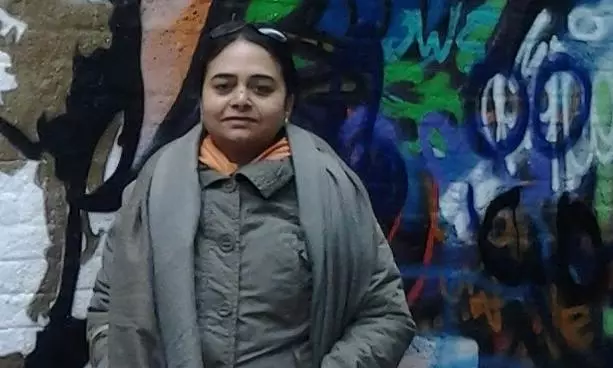A mind full of calm

Meditation can be a challenge for many people — they may struggle to sit still and focus their thoughts. But there are many mindfulness techniques which can do what meditation does — relax and reduce stress and anxiety. NSDR or Non-Sleep Deep Rest is one such technique, endorsed by none other than the Google CEO Sundar Pichai.
The Google honcho’s go-to podcasts for relaxation include ones based on NSDR, which involves lying in place, unmoving, and directing your awareness to the rise and fall of your breath and the sensations in different parts of the body. It also often includes a guided imagery aspect. (You are led by an instructor who reads and involves a specific script that guides you through a body scan). “While I find it difficult to meditate, I can go to YouTube [and] find an NSDR video,” Pichai was quoted as saying.
NSDR can help people relax, fall asleep more easily, ease stress, anxiety and pain, and even accelerate learning.
A pre-meditation step
“Meditation is a powerful stress management and personal growth tool that everyone can benefit from. Regular meditation helps you relax and unwind; it improves memory and decision-making, and makes you more balanced emotionally. However, meditation can be challenging for many people who may struggle to sit still with their thoughts,” says Namita Piparaiya, Yoga and Ayurveda Lifestyle Specialist, and Founder, Yoganama.
There are many other mindfulness techniques that can help you reach similar states of relaxation and stillness. “These techniques are a great way to train the body and mind for traditional meditation that requires unwavering focus and concentration,” explains Namita.
NSDR is a term coined by Andrew Huberman, a neuroscientist and Professor at Stanford University. “I have been using NSDR daily for ~10 years and find [it] to be among the more powerful tools for recovering lost sleep, focus & neuroplasticity,” he wrote on Twitter. He also spoke at length about NSDR on The Tim Ferriss Show, a podcast, in 2021.
According to Namita, NSDR protocols have two primary aspects — Yoga Nidra and Self-hypnosis. Self-hypnosis is an individual practice, unlike when you are working with a therapist. “Both techniques involve directing the mind to a state of calm, while also directing your focus to something specific via visualization.
Between wakefulness and sleep
Yoga Nidra is also very effective at unlocking creativity, giving you new ideas and helping to solve old problems. Thomas Edison, John Keats and Salvador Dali are believed to have practiced Yoga Nidra to find creative inspiration.
Yoga Nidra is a guided meditation technique done in a relaxed, lying down position. The instructor’s voice guides you through the session as you enter into a deep restful state, where you’re neither fully awake, nor asleep. A complete Yoga Nidra session has 8 stages, which include withdrawal of senses, setting an intention, rotation of consciousness to different parts of the body, scenic visualization etc. An interesting step in Yoga Nidra involves experiencing opposites, like pain/pleasure, heat/cold etc. These activate different areas of the brain in quick succession, improving adaptability and resilience.
The goal of it is to maintain awareness in a state where you’re just about to fall asleep, but not actually sleeping. This is called the ‘wakeful sleep stage’ or in technical terms, the hypnagogic state. The ability to hold your awareness in this state for a prolonged period of time helps you manage stress, reduce anxiety, enhance cognitive performance, and sleep better.
These techniques can also help weight loss, improve confidence, quit harmful habits like smoking and also manage pain.
The process
Namita explains how a session of Yogic Nidra would work:
“Let’s assume the goal is to recover from a knee injury. Begin with eyes closed and be aware of your breathing. Breath is a powerful meditation and relaxation tool and a great way to induce a state of calm. By simply slowing down your breath and lengthening your exhalation you can calm your nervous system. Once relaxed and comfortable, begin visualization — maybe you like walking in the park. Picture yourself walking pain free in the garden, affirming to yourself that you’re walking without pain, enjoying the moment, and that all is good. Add as much detail as you can to your visualization, making it vivid, real and intuitive. After 5 minutes or more, you can gradually return to the present moment, bringing your awareness back to your breathing.”
Progressive Muscle Relaxation
Another very helpful stress management technique is Progressive Muscle Relaxation. “In this you relax each muscle of the body, one by one. You first tighten and tense up a group of muscles as you inhale and then immediately relax them as you exhale. Muscle tension is held for 5 to 10 seconds and then relaxed. After 15-20 seconds of rest, the next set of muscles are tensed and relaxed. Clenching the hands, shrugging shoulders, wrinkling the forehead, pressing the back of the head against the mat, arching the back and sucking in the stomach are some examples of tensing up the muscles. The process is repeated till the whole body has been covered,” says Namita. “This practice is based on the premise that if the body is calm, then so will the mind. It is a powerful practice that is helpful in tension headaches, digestive issues, insomnia, and high BP.”
Accessible to all
These multiple mindfulness practices are not only rejuvenating, they also prepare the practitioner for traditional meditation requiring sustained focus and concentration. The best part is, they cost nothing, are easily accessible and highly empowering and can be done by anyone. “All it takes is 15-20 mins of practice a day to transform your body and mind. I hope you’ll make time for these in your daily routine,” says Namita.

